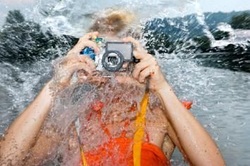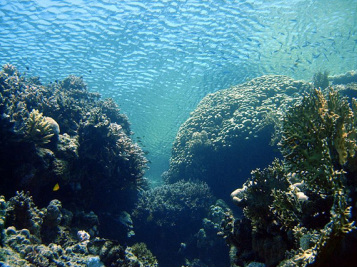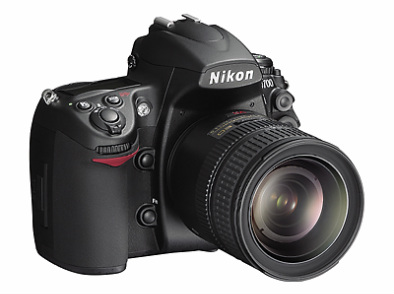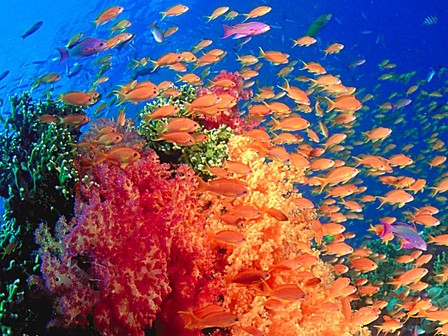Top Underwater Camera Reviews

There are few underwater digital cameras, as cameras are electronic and they must be carefully designed to endure water and water pressure. The closest consumer electronics has ever got to creating underwater digital cameras are manufacturing underwater casings for digital cameras. These holders can turn your standard digital camera into an underwater digital camera. If you are capturing with your underwater digital camera and underwater video, it is important for you to take note of a few things to help you come up with the best photographs underwater. Take into account that when you go a greater distance below water, light diffuses. In other words your underwater digital camera can create pictures darker versus those photos you took while on land – it is because of the light diffusion the red spectrum might seem darker. To prevent this happening, use white balance produce natural colors.
Target User
1) New underwater photographer wanting an easy point & shoot camera with growth potential.
2) Advanced underwater photographer wanting a compact camera solution.
Camera Feature Requirements -
1) Great to excellent image quality.
2) Camera must fit in a pocket when used topside.
3) Camera must be point & shoot easy, but offer intermediate to advanced controls.
4) Underwater housing must easily work with underwater strobes.
5) Underwater housing must accommodate wide angle lenses.
An underwater digital camera possessing built-in flash will produce oceanic display phenomenon. It can be a phenomenon in which your photos come out as wooly and with white particles suspended above it, to avoid this phenomenon it is advisable to employ external flash for your underwater digital camera.
Prior to using your underwater digital camera, immerse the camera inside the fluid initially for several minutes subsequently check whether you will find leaks through the case. Make perfectly sure that no grain of sand or portion of hair is caught in between the seal to make sure that fluids is not going to permeate the case and thus wet your camera in the process. It is equally advisable to place silica gel inside the case of your underwater digital camera as long as it don’t disturb the camera’s function.
Target User
1) New underwater photographer wanting an easy point & shoot camera with growth potential.
2) Advanced underwater photographer wanting a compact camera solution.
Camera Feature Requirements -
1) Great to excellent image quality.
2) Camera must fit in a pocket when used topside.
3) Camera must be point & shoot easy, but offer intermediate to advanced controls.
4) Underwater housing must easily work with underwater strobes.
5) Underwater housing must accommodate wide angle lenses.
An underwater digital camera possessing built-in flash will produce oceanic display phenomenon. It can be a phenomenon in which your photos come out as wooly and with white particles suspended above it, to avoid this phenomenon it is advisable to employ external flash for your underwater digital camera.
Prior to using your underwater digital camera, immerse the camera inside the fluid initially for several minutes subsequently check whether you will find leaks through the case. Make perfectly sure that no grain of sand or portion of hair is caught in between the seal to make sure that fluids is not going to permeate the case and thus wet your camera in the process. It is equally advisable to place silica gel inside the case of your underwater digital camera as long as it don’t disturb the camera’s function.
Choose the right underwater camera
Many different models of underwater cameras are available today with different features and specifications. As not all underwater cameras take the best of photos underwater, it is better to take an in-depth review of the products, so that you do not waste money on a product that does not meet your expectations.Operate the camera in shallow water and when it is broad daylight. Large amounts of water have an inclination to reflect light, which makes the water appear darker. Seas and oceans have particularly dark waters because of their murky appearances. That is why it is best to use the camera when the environment is bright or sunny.
Take photos as still as possible - If you are in water where there are lots of people splashing or waves such as a pool or the sea, then it maybe difficult to get a good picture underwater.
Fasten the camera somewhere close by - Make sure you attach the camera to your wrist with the help of a wrist strap, or to the bathing suit using clipping.
Follow depth recommendations - No underwater camera is free of limitations in terms of how deep underwater you can take them. It is a good idea to follow the depth recommendations that come with your camera.
It can be used just like a regular camera - The majority of underwater cameras offer features and functions that are the same as on standard cameras.
Take photos as still as possible - If you are in water where there are lots of people splashing or waves such as a pool or the sea, then it maybe difficult to get a good picture underwater.
Fasten the camera somewhere close by - Make sure you attach the camera to your wrist with the help of a wrist strap, or to the bathing suit using clipping.
Follow depth recommendations - No underwater camera is free of limitations in terms of how deep underwater you can take them. It is a good idea to follow the depth recommendations that come with your camera.
It can be used just like a regular camera - The majority of underwater cameras offer features and functions that are the same as on standard cameras.
Finding the underwater digital camera that best meets your diving expectations can be a challenge.

# Evaluate the size of the underwater camera's buttons carefully. If your underwater picture taking is going to be done with scuba gear on, pressing a minuscule flash button will be frustrating. A scuba glove friendly underwater camera with pronounced buttons will be the best underwater digital camera to use with all the gear on.
# 2 Consider the depth of your underwater photo shoot as well. To find the best underwater camera for your needs one must factor in the underwater lighting. If you plan on staying within 40 ft of the surface a basic point and shoot underwater digital camera will be fine. If you plan on going further underwater, a cheap underwater camera is going to be pointless.
# 3 Take advantage of online consumer resources to compare underwater digital cameras. It is always beneficial to read underwater digital camera reviews from consumers that have tried a camera before making a choice (see resources).
# 2 Consider the depth of your underwater photo shoot as well. To find the best underwater camera for your needs one must factor in the underwater lighting. If you plan on staying within 40 ft of the surface a basic point and shoot underwater digital camera will be fine. If you plan on going further underwater, a cheap underwater camera is going to be pointless.
# 3 Take advantage of online consumer resources to compare underwater digital cameras. It is always beneficial to read underwater digital camera reviews from consumers that have tried a camera before making a choice (see resources).
Recommended underwater DSLR lens choices

In this guide to the best underwater lenses, we will look at the best choices for dslr cameras such as the Canon 50D, Canon 5d, Canon 7d, nikon D90, Nikon D300 & D300s, Nikon D3, olympus E3, Olympus e620, and other dSLR models.
Properties of Water - Shooting underwater has its challenges, due to the properties of water. Understanding these properties is essential to understand the basics of underwater photography.
* The refractive index of water is different than air, which makes judging distances difficult. Objects viewed through your mask can appear 25% larger than they really are, due to the refractive index difference.
* Water absorbs light. Light levels quickly drop as you get deeper in water. In addition, red is absorbed faster than blues. See loss of color underwater section
* Water sucks contrast and sharpness in photos. This is why you must always get as close as possible to your subject.
Quality of Light - The light that creates your exposure will come from your strobes, dive lights, focus lights, and the sun. People often talk about the "quality" of light, which depends on these 4 factors listed below, no matter what the source is:
* Amount of light. It is generally more difficult to shoot in low light, although low light can be helpful for some creative effects such as panning or showing motion.
* Color of the light
* Direction of light
* Amount of diffusion or softness
Compact underwater camera advantages:
* Smaller size for travel
* Less drag underwater
* Ability to change lenses underwater (Wet lenses)
* Much less cost (although the cost of a high-end housing, wet lenses, adapters, etc. can start to add up)
* Less weight, easier to carry and beach dive with
* Shoots video underwater, although the Nikon D90, Canon 5DMkII and others now do video
* With wet lenses, you can shoot macro, Wide-angle, and video all in 1 dive
Compact underwater camera disadvantages:
* Smaller sensor (more noise, smaller dynamic range, etc.)
* Increased shutter delay and focus delay over a dSLR - this is the biggest complain of many people
* Optics are a lesser quality
* Less choices for good quality lenses
* Only a couple models can shoot in raw and use a true fisheye lens
* Very slow raw write speeds, if raw is offered - although this has improved in a couple recent models
* Less battery life
* Noisy at high ISO's, although high ISO has limited use underwater, so this is not a big factor.
* Less control over depth of field. A larger-sensor dSLR will have a smaller depth of field at a large aperture, giving a blurred background that is difficult to accomplish with a compact camera.
Couples that are looking for incredible extremely dissimilar from their customary surroundings are now bearing in mind the alternative of a Destination Wedding Photographer. Part of this enclose includes the services of an expert photographer. An Indian Wedding Photographer notes the details. It is not trouble-free to imprison all the particular moments let alone something so grand like wedding. If marriages are completed in paradise, the marriage shots are captured on ground.
Properties of Water - Shooting underwater has its challenges, due to the properties of water. Understanding these properties is essential to understand the basics of underwater photography.
* The refractive index of water is different than air, which makes judging distances difficult. Objects viewed through your mask can appear 25% larger than they really are, due to the refractive index difference.
* Water absorbs light. Light levels quickly drop as you get deeper in water. In addition, red is absorbed faster than blues. See loss of color underwater section
* Water sucks contrast and sharpness in photos. This is why you must always get as close as possible to your subject.
Quality of Light - The light that creates your exposure will come from your strobes, dive lights, focus lights, and the sun. People often talk about the "quality" of light, which depends on these 4 factors listed below, no matter what the source is:
* Amount of light. It is generally more difficult to shoot in low light, although low light can be helpful for some creative effects such as panning or showing motion.
* Color of the light
* Direction of light
* Amount of diffusion or softness
Compact underwater camera advantages:
* Smaller size for travel
* Less drag underwater
* Ability to change lenses underwater (Wet lenses)
* Much less cost (although the cost of a high-end housing, wet lenses, adapters, etc. can start to add up)
* Less weight, easier to carry and beach dive with
* Shoots video underwater, although the Nikon D90, Canon 5DMkII and others now do video
* With wet lenses, you can shoot macro, Wide-angle, and video all in 1 dive
Compact underwater camera disadvantages:
* Smaller sensor (more noise, smaller dynamic range, etc.)
* Increased shutter delay and focus delay over a dSLR - this is the biggest complain of many people
* Optics are a lesser quality
* Less choices for good quality lenses
* Only a couple models can shoot in raw and use a true fisheye lens
* Very slow raw write speeds, if raw is offered - although this has improved in a couple recent models
* Less battery life
* Noisy at high ISO's, although high ISO has limited use underwater, so this is not a big factor.
* Less control over depth of field. A larger-sensor dSLR will have a smaller depth of field at a large aperture, giving a blurred background that is difficult to accomplish with a compact camera.
Couples that are looking for incredible extremely dissimilar from their customary surroundings are now bearing in mind the alternative of a Destination Wedding Photographer. Part of this enclose includes the services of an expert photographer. An Indian Wedding Photographer notes the details. It is not trouble-free to imprison all the particular moments let alone something so grand like wedding. If marriages are completed in paradise, the marriage shots are captured on ground.

